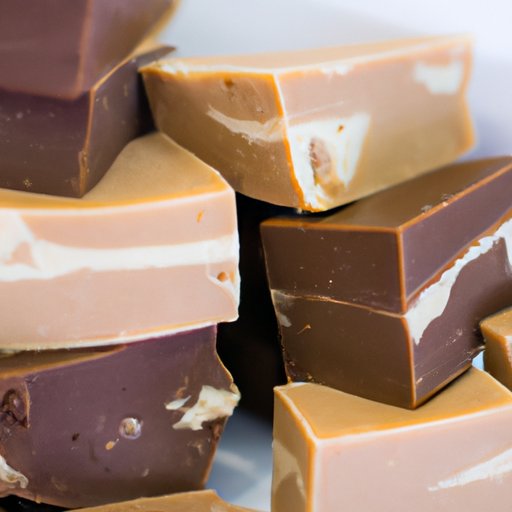
Introduction
Fudge is a delectable treat that satisfies one’s sweet tooth instantly! Whether you are looking for a classic chocolate fudge or a unique flavor that tickles your taste buds, making fudge from scratch is a fun and rewarding experience. In this article, we will provide you with a detailed step-by-step guide on how to make fudge, tips to ensure success, and information on fudge regional styles, history and evolution, healthier alternatives, unique flavors, recipes for special occasions, and how to avoid common mistakes. Let’s dive into the world of fudge making!
Step-by-Step Recipe
Making fudge requires only a few ingredients and equipment. Here’s what you’ll need:
- 2 cups granulated sugar
- 1 cup unsweetened cocoa powder
- 1 teaspoon salt
- 1 1/2 cups heavy cream
- 1/2 cup unsalted butter
- 1 teaspoon vanilla extract
Equipment:
- Medium saucepan
- 9×9 inch pan, lined with parchment paper
- Candy thermometer (optional)
Now that you have everything you need, let’s dive into the recipe:
- Combine sugar, cocoa powder, and salt in a medium saucepan.
- Add heavy cream, butter, and vanilla extract to the saucepan and stir to combine.
- Heat the mixture over medium heat and keep stirring until the butter melts.
- Bring the mixture to a boil, stirring frequently, until it reaches the soft ball stage (235-240°F) on the candy thermometer. If you don’t have a thermometer, you can use the water test: drop a spoonful of hot mixture into a cup of cold water and it should form a soft ball
- Remove from heat and let it cool for a few minutes.
- Using a wooden spoon or whisk, beat the fudge until it thickens and starts to lose its glossy sheen. This should take about ten minutes of continuous stirring.
- Spread the mixture onto the prepared pan, let the fudge cool to room temperature, and then chill it in the refrigerator for a few hours or overnight.
- Cut the fudge into small squares and serve!
And there you have it! A simple yet delicious fudge recipe that will leave you wanting more. You can also try variations, such as adding chopped nuts or different flavor extracts for a unique twist.
Regional Styles
Fudge has been a beloved treat in the United States for over a century, and with time, regional variations have emerged. Southern fudge is known for its creaminess while Northeastern fudge has a more traditional grainy texture. Southern fudge often contains marshmallows and sometimes pecans or peanut butter, while northeastern fudge tends to have a more straightforward chocolate flavor.
History and Evolution
The origin of fudge is uncertain. According to one legend, fudge was accidentally created in 1886 when a batch of caramels went awry at Vassar College. Another tale attributes its creation to a woman selling fudge to support the college football team in Baltimore. Regardless of its origins, fudge quickly gained popularity in the United States and beyond, with various countries and cultures putting their spin on the recipe.
Over the years, the recipe for fudge has evolved to the current form, but its essential ingredients and method have remained the same. Fudge has become a staple during holiday baking and a sweet treat for any occasion.
Healthier Alternatives
Fudge is known for its high sugar and fat content, leading to health concerns when consumed excessively. To create healthier fudge, consider substituting cream for low-fat milk, honey or maple syrup for sugar, or using nut butter instead of sweetened condensed milk. Keep in mind that enjoyment in moderation is essential and every little thing you can do to make it healthier can be helpful.
Unique Flavors
The beauty of fudge is its endless possibilities for flavor combinations. Consider adding ingredients like mint extract or shredded coconut for savory fudge, or lavender and honey or bacon for unique sweet fudge. Use your imagination, and enjoy exploring the world of fudge-making!
Fudge for Special Occasions
Fudge makes a thoughtful and tasty gift for special occasions. You can package it in decorative boxes and wrap it in colorful ribbons. You can also customize your fudge by adding nuts, dried fruits, or other ingredients that complement the occasion’s theme.
When storing fudge, it’s best to keep it in an airtight container in the refrigerator for up to two weeks. It can be stored in the freezer for up to two months, but be sure to wrap it tightly in plastic wrap and a layer of foil before freezing.
Fudge Failures and How to Avoid Them
Like any recipe, fudge takes practice to perfect. Common mistakes when making fudge include not stirring the mixture enough, overcooking it, and failing to achieve the soft ball stage. To avoid these issues, remember to keep stirring the mixture consistently, use a thermometer, and keep track of the fudge’s temperature.
Conclusion
Fudge is a sweet and irresistible treat that you can prepare with ease. By following our recipe and tips, trying different regional styles and flavors, and experimenting on your own, you can master the art of fudge-making. Be sure to remember health concerns when indulging in a sweet treat such as fudge, and enjoy every bite in moderation.





